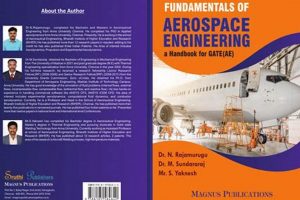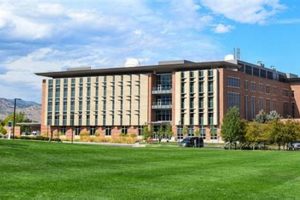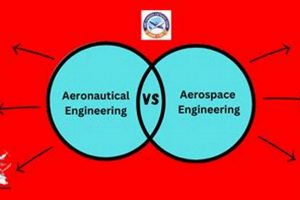Inquiries related to the design, development, testing, and production of aircraft and spacecraft, as well as related technologies, represent a critical aspect of the field. These inquiries explore a wide range of topics, from fundamental physics and mathematics to advanced materials science and propulsion systems. For example, examining the optimal wing shape for supersonic flight or evaluating the feasibility of a new rocket engine design would fall under this category.
The act of posing these inquiries fosters innovation and drives progress within the aviation and space exploration sectors. Historically, rigorous investigation has led to breakthroughs in aircraft performance, satellite technology, and space travel capabilities. This process is crucial for ensuring the safety, efficiency, and sustainability of aerial and space-bound vehicles and systems.
The following will address several key areas frequently subject to scrutiny within this discipline, encompassing topics such as fluid dynamics, structural analysis, propulsion systems, and control engineering, providing a foundational understanding of their significance. These areas are essential for navigating the complexities of flight within the atmosphere and beyond.
Guidance for Aerospace Engineering Inquiries
Formulating effective queries is crucial for navigating the complexities of aerospace engineering. The following guidelines will assist in structuring inquiries to elicit the most informative and useful responses.
Tip 1: Define the Scope Precisely: Clearly articulate the specific area of aerospace engineering under consideration. For instance, instead of broadly asking about “aerodynamics,” focus on “boundary layer separation at high angles of attack on delta wings.”
Tip 2: Frame the Problem Quantitatively: Whenever possible, express the inquiry in terms of measurable parameters and desired outcomes. Instead of asking “How can performance be improved?”, inquire “How can the lift-to-drag ratio of this airfoil be increased by 10% at Mach 0.8?”
Tip 3: Provide Relevant Context: Include pertinent details about the system, environment, and constraints being analyzed. Stating the operating conditions, material properties, and regulatory requirements will enhance the relevance of the response.
Tip 4: Prioritize Specificity over Generality: Vague requests yield equally vague answers. Rather than asking “What are the future trends in propulsion?”, focus on “What is the projected advancement in specific impulse for electric propulsion systems over the next decade?”
Tip 5: Consider Underlying Assumptions: Acknowledge and state any assumptions being made. For example, if analyzing structural integrity, specify the type of loading, failure criteria, and material homogeneity assumptions.
Tip 6: Consult Existing Literature: Before formulating an inquiry, conduct a thorough literature review to avoid duplicating previously addressed questions. This includes examining academic journals, industry publications, and technical reports.
Tip 7: Decompose Complex Problems: Break down intricate challenges into smaller, more manageable sub-problems. This modular approach facilitates a more targeted and effective investigative process.
Effective questioning is paramount in the field, streamlining problem-solving and fostering deeper comprehension. Employing these tips enhances clarity, precision, and the overall efficiency of the engineering process.
With a solid foundation of questions, the path to understanding these disciplines is much smoother, thus let’s see the main areas.
1. Aerodynamics Optimization
Aerodynamics optimization, inherently linked to inquiries concerning aerospace engineering, represents a crucial discipline focused on enhancing the performance of vehicles operating within a fluid environment. The questions central to this field directly influence the design, efficiency, and safety of aircraft, spacecraft, and other related technologies. Cause and effect are paramount; modifications to an aerodynamic profile directly impact lift, drag, and overall stability. The pursuit of enhanced aerodynamic performance requires rigorous inquiry into fluid flow behavior, material properties, and the application of computational tools.
Aerodynamics optimization serves as a cornerstone within the broader scope of aerospace engineering inquiries due to its direct impact on vehicle capabilities. A practical example is the design of winglets on commercial aircraft. Through careful computational fluid dynamics analysis and wind tunnel testing, engineers optimize winglet geometry to reduce induced drag, resulting in improved fuel efficiency and extended flight ranges. Similarly, the shaping of hypersonic vehicles demands intense aerodynamic scrutiny to manage shockwave formation and minimize heat transfer to the airframe. Without these targeted inquiries, the performance envelopes of such vehicles would be severely limited.
In conclusion, the field of aerodynamics optimization is propelled by rigorous exploration and interrogation. The questions posed within this domain directly shape the characteristics of aerospace vehicles, influencing their efficiency, stability, and overall effectiveness. The understanding derived from these investigations, and the application of real-world engineering examples solidifies its significance within aerospace design and performance.
2. Materials Performance Limits
The assessment of materials performance limits is inextricably linked to aerospace engineering endeavors, forming a critical area of inquiry that dictates the feasibility and longevity of aerospace systems. Understanding the boundaries of what materials can withstand under extreme conditions directly shapes design choices and operational parameters.
- Thermal Resistance under Hypersonic Conditions
The ability of materials to maintain structural integrity at extreme temperatures generated during hypersonic flight is paramount. Questions arise regarding ablation rates of thermal protection systems, oxidation resistance of high-temperature alloys, and the effectiveness of cooling mechanisms. Examples include the use of carbon-carbon composites on the Space Shuttle and the development of ceramic matrix composites for future hypersonic vehicles. Insufficient thermal resistance can lead to catastrophic failure due to material degradation or structural deformation.
- Fatigue Resistance under Cyclic Loading
Aerospace components are subjected to repeated stress cycles during operation, leading to fatigue. Inquiries focus on the fatigue life of materials under varying load conditions, the impact of stress concentrations, and the effectiveness of non-destructive testing methods. The Aloha Airlines Flight 243 incident, caused by fatigue cracking in the fuselage, exemplifies the critical importance of understanding fatigue limits. Regular inspections and careful material selection are essential for mitigating fatigue-related failures.
- Radiation Hardness in Space Environments
Materials used in spacecraft must withstand prolonged exposure to ionizing radiation. Inquiries center on the degradation of material properties due to radiation damage, the effectiveness of shielding techniques, and the development of radiation-hardened materials. The performance of electronic components and the structural integrity of spacecraft are directly affected by radiation exposure. Understanding these effects is crucial for ensuring long-term mission success in space.
- Strength-to-Weight Ratio Optimization
Minimizing weight while maintaining sufficient strength is a primary design driver in aerospace engineering. Questions concern the maximum achievable strength-to-weight ratio for different materials, the impact of manufacturing processes on material properties, and the trade-offs between cost and performance. The increasing use of composite materials in aircraft structures, such as carbon fiber reinforced polymers, demonstrates the emphasis on lightweight design. Achieving optimal strength-to-weight ratios is essential for improving fuel efficiency and increasing payload capacity.
These facets highlight the multifaceted nature of materials performance limits and their central role in addressing inquiries related to aerospace engineering. Each area necessitates rigorous investigation and careful consideration to ensure the safety, reliability, and performance of aerospace systems. The ongoing pursuit of materials with enhanced capabilities continues to drive innovation and expands the possibilities for future aerospace endeavors.
3. Propulsion Efficiency Maximization
Propulsion efficiency maximization is a fundamental pursuit within aerospace engineering, directly addressing inquiries concerning vehicle performance, fuel consumption, and overall mission viability. The pursuit of greater efficiency drives advancements in engine design, fuel technology, and operational strategies, significantly impacting both economic and environmental considerations.
- Advanced Engine Cycle Development
The exploration of novel thermodynamic cycles forms a critical area within propulsion efficiency maximization. Questions concerning the feasibility and performance of cycles such as the Brayton cycle with intercooling and reheating, the combined cycle, and the pulse detonation engine are actively investigated. These cycles aim to extract more work from the fuel’s energy, thereby increasing overall efficiency. Real-world examples include research into rotating detonation engines for hypersonic vehicles and the development of more efficient turbofan engines for commercial aviation. The insights gained directly inform design decisions and technology development strategies.
- Combustion Optimization
Achieving complete and efficient combustion is paramount for maximizing the energy extracted from the fuel. Inquiries focus on optimizing fuel-air mixing, reducing combustion instability, and minimizing pollutant formation. Techniques such as lean premixed pre-vaporized combustion and staged combustion are employed to enhance combustion efficiency. The development of low-emission combustors for gas turbine engines and the implementation of advanced fuel injection systems exemplify this area. Effective combustion optimization directly translates to reduced fuel consumption and lower environmental impact.
- Nozzle Design and Performance
The nozzle plays a crucial role in converting the thermal energy of the exhaust gases into kinetic energy, thereby generating thrust. Questions concerning nozzle geometry, expansion ratio, and flow control are essential for optimizing nozzle performance. Variable geometry nozzles, ejector nozzles, and plug nozzles are examples of advanced nozzle designs aimed at maximizing thrust efficiency. The design of high-performance nozzles for rocket engines and the implementation of thrust vectoring systems demonstrate the importance of this area. Optimized nozzle performance directly contributes to increased vehicle speed and maneuverability.
- Fuel Technology Advancement
The energy content and combustion characteristics of the fuel directly influence propulsion efficiency. Inquiries focus on the development of high-energy-density fuels, such as liquid hydrogen and synthetic hydrocarbons, as well as the implementation of advanced fuel management systems. Research into biofuels and alternative fuels also plays a significant role. The use of liquid hydrogen as a rocket propellant and the development of JP-8+10 fuel additives for jet engines exemplify this area. Fuel technology advancements directly impact engine performance, range, and payload capacity.
These facets collectively illustrate the intricate relationship between propulsion efficiency maximization and core inquiries within aerospace engineering. Each area demands rigorous investigation and careful consideration to improve vehicle performance, reduce fuel consumption, and mitigate environmental impact. The continued pursuit of more efficient propulsion systems is essential for enabling future aerospace endeavors and ensuring the sustainability of air and space travel.
4. Control System Stability
Control system stability, a critical facet of inquiries within aerospace engineering, concerns the capacity of an aircraft or spacecraft’s automated and manual control mechanisms to maintain a desired state or trajectory without uncontrolled oscillations or divergence. This is not merely a desirable attribute but an absolute necessity for safe and effective operation. The consequences of instability range from minor discomfort for passengers to catastrophic loss of the vehicle. The inherent dynamics of flight, coupled with external disturbances such as wind gusts or atmospheric turbulence, necessitate sophisticated control systems capable of counteracting these influences and maintaining equilibrium.
The importance of control system stability manifests across numerous aspects of aerospace vehicle design and operation. For example, the development of fly-by-wire systems in modern aircraft necessitates rigorous stability analysis to ensure pilot inputs translate into predictable and controlled maneuvers. Without such analysis, unintended consequences, such as pilot-induced oscillations, could arise. In spacecraft, attitude control systems rely on precise sensor measurements and actuator commands to maintain a stable orientation, essential for communication, navigation, and scientific observation. The failure of a control system to maintain stability can render a mission useless or even lead to the loss of the spacecraft. The Boeing 737 MAX incidents highlight the dire consequences of inadequately tested and implemented control augmentation systems, underscoring the real-world implications of prioritizing stability in control system design.
In summary, control system stability forms an indispensable area of inquiry within aerospace engineering. It is not simply a desirable characteristic, but a fundamental requirement for the safe and effective operation of aircraft and spacecraft. From the design of flight control laws to the implementation of attitude control systems, ensuring stability is paramount. The inherent challenges associated with flight dynamics and the potential for catastrophic consequences necessitate rigorous analysis, testing, and validation of control systems to guarantee their stability under all operational conditions. The continued focus on this area will drive advancements in control system design and enhance the safety and reliability of future aerospace endeavors.
5. Mission Feasibility Assessment
Mission feasibility assessment, inherently reliant on inquiries within aerospace engineering, constitutes a critical evaluation of the viability of a proposed aerospace endeavor. This process involves a systematic examination of technical, economic, and programmatic factors to determine the likelihood of mission success. The rigor and comprehensiveness of this assessment are directly proportional to the probability of avoiding costly failures and achieving mission objectives. The central purpose of a feasibility assessment is to identify potential risks, challenges, and limitations that could impede mission success, allowing for informed decision-making and resource allocation.
The connection between mission feasibility assessment and general aerospace inquiries is particularly evident in specific phases of mission development. For example, during the conceptual design phase of a Mars rover mission, feasibility assessments scrutinize the availability and maturity of critical technologies such as autonomous navigation systems, radiation-hardened electronics, and reliable power sources. Without sufficient technological readiness, the mission could face significant delays or even cancellation. Economically, feasibility studies evaluate the projected costs of development, launch, and operation, comparing them against available funding and potential scientific returns. A lack of economic viability can severely constrain mission scope or necessitate the adoption of more cost-effective alternatives. Programmatically, assessments examine the organizational structure, management capabilities, and regulatory compliance aspects, addressing potential logistical and bureaucratic impediments.
In conclusion, the value of mission feasibility assessment is predicated on rigorous questioning across numerous aerospace disciplines. It necessitates a multidisciplinary approach, drawing upon expertise in engineering, economics, and management, to identify and mitigate potential risks. Successfully implemented, the process supports the selection of viable mission concepts, reduces the likelihood of costly failures, and maximizes the chances of achieving scientific objectives. Real-world examples of canceled or significantly altered missions demonstrate the practical significance of thorough feasibility studies and underline their role as a vital component of the broader landscape of aerospace engineering inquiries.
Frequently Asked Questions about Aerospace Engineering
This section addresses common inquiries related to the field, providing concise and informative answers based on established principles and practices.
Question 1: What are the primary disciplines within Aerospace Engineering?
Aerospace engineering encompasses two primary and often overlapping disciplines: aeronautical engineering, concerned with aircraft operating within Earth’s atmosphere, and astronautical engineering, dealing with spacecraft and other vehicles operating outside the Earth’s atmosphere. These disciplines share a common foundation in mathematics, physics, and engineering principles but diverge in their specific applications and design considerations.
Question 2: What educational qualifications are generally required for a career in Aerospace Engineering?
A Bachelor of Science degree in Aerospace Engineering or a closely related field is typically the minimum requirement for entry-level positions. Advanced positions, particularly those involving research and development, often necessitate a Master of Science or Doctoral degree. Accreditation from ABET (Accreditation Board for Engineering and Technology) is highly recommended for undergraduate programs.
Question 3: What career opportunities are available to Aerospace Engineers?
Aerospace engineers find employment in a variety of sectors, including the aerospace industry, government agencies (such as NASA and national defense organizations), research institutions, and consulting firms. Specific roles may include aircraft design, spacecraft development, propulsion system engineering, flight testing, and mission planning. Opportunities also exist in related fields such as robotics, materials science, and software engineering.
Question 4: What are the key skills required for success in Aerospace Engineering?
Success in aerospace engineering demands a strong foundation in mathematics, physics, and computer science, coupled with proficiency in engineering design principles. Essential skills include problem-solving, critical thinking, teamwork, communication, and the ability to apply theoretical knowledge to practical applications. Familiarity with industry-standard software tools for modeling, simulation, and analysis is also crucial.
Question 5: What are some of the significant current trends in Aerospace Engineering?
Current trends include the development of more fuel-efficient aircraft, the exploration of sustainable aviation fuels, the design of unmanned aerial vehicles (UAVs), the advancement of space exploration technologies, and the application of additive manufacturing (3D printing) to aerospace components. Emphasis is also placed on the development of autonomous systems and the integration of artificial intelligence into aerospace applications.
Question 6: What role does research and development play in Aerospace Engineering?
Research and development (R&D) are integral to the advancement of aerospace engineering. R&D efforts focus on developing new technologies, improving existing systems, and addressing emerging challenges. Research activities span a wide range of topics, including aerodynamics, propulsion, materials science, control systems, and space exploration. Funding for R&D comes from government agencies, private companies, and academic institutions.
In summary, aerospace engineering is a multifaceted field requiring a strong technical foundation, problem-solving acumen, and a commitment to continuous learning. Understanding these fundamental aspects is crucial for those considering a career in this dynamic and challenging discipline.
The next section will delve into specific challenges and opportunities within the aerospace sector.
Questions About Aerospace Engineering
The preceding exploration has underscored the critical role of rigorous inquiry in advancing the field. From aerodynamics optimization and materials performance to propulsion efficiency, control system stability, and mission feasibility, questioning forms the bedrock of progress. Understanding the scope and nature of these inquiries is essential for all stakeholders, including engineers, researchers, policymakers, and students. The continuous pursuit of knowledge through targeted investigation is paramount for ensuring the safety, efficiency, and sustainability of aerospace endeavors.
The future of aerospace engineering hinges on the ability to formulate and address increasingly complex queries. As technology evolves and new challenges emerge, a commitment to intellectual curiosity and rigorous analysis will be indispensable. Continued investment in research and education, coupled with a focus on interdisciplinary collaboration, will pave the way for groundbreaking discoveries and transformative innovations. The sustained exploration of these questions will ultimately shape the trajectory of air and space travel for generations to come.







